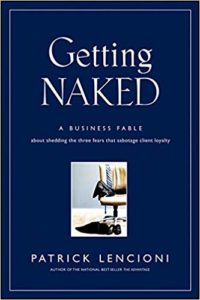 I recently read Patrick Lencioni’s latest book, Getting Naked: A Business Fable About Shedding The Three Fears That Sabotage Client Loyalty. I found the book useful, well written, and insightful.
I recently read Patrick Lencioni’s latest book, Getting Naked: A Business Fable About Shedding The Three Fears That Sabotage Client Loyalty. I found the book useful, well written, and insightful.
Here is a quick summary of the key ideas:
Always Consult instead of Sell
Rather than harping on past accolades and what you can do if the organization hires you, transform every sales situation into an opportunity to demonstrate value. Start adding value from the very first meeting… without waiting to be hired. Don’t worry about a potential client taking advantage of your generosity. (One potential client in 10 may – but you don’t want that one potential client as a customer anyway!)
Tell kind truth
Be ready to confront a client with a problematic message, even if the client might not like hearing it. Don’t sugar coat or be obsequious. Rather, replay the message in a manner that recognizes the dignity and humanity of the client. Be prepared to deal with “the elephant in the room” that everyone else (including your competitors) is afraid to address.
Don’t be afraid to ask questions or suggest ideas, even if they seem obvious
There is a good chance that a seemingly obvious question/suggestion is actually of benefit to many in the audience.
Of course, there is also that chance of posing a “dumb” question. But no one is expecting perfection from their consultants, but they do expect transparency and honesty. There is no better way to demonstrate both than by acknowledging mistakes.
Make everything about the client
Be prepared to humble yourself by sacrificially taking the burden off of a client in a difficult situation. Be ready to take on whatever the client needs you to do within the context of the services you offer.
The focus of all of your attention needs to be on understanding, supporting, and honoring the business of the client. Do not try to shift attention to yourself, your skills, or your knowledge. Honor the client’s work by taking an active interest in their business and appreciating the importance of their work.
Admit your weaknesses and limitations
Be true to your strengths and be open to admitting your weaknesses. Not doing so will wear you out and prevent you from doing your best in your areas of strength.
Like many of you, we at AIS attempt to subsume many of the above ideas from Lencioni’s book. For example, rather than “sell” a project, we often co-invest (along with the customer) in a micro-POC* or a one-day architecture and design session that helps lay out the vision for the solution, identify main risks, and crystallize the requirements for a project. With the insights derived from a micro-POC, clients can make an informed decision on whether to move forward or not. Here are a couple of examples of micro-POCs: Jupyter Notebooks as a Custom Calculation Engine, and Just-in-Time Permission Control with Azure RBAC
* Micro-POC (micro Proof of concept) – a time-boxed (typically ~40 hours) “working” realization of an idea/concept with the aim to better understand the potential, risks, and effort involved. This is *not* an early version of a production application. Also, see this Wikipedia definition of Proof of concept






